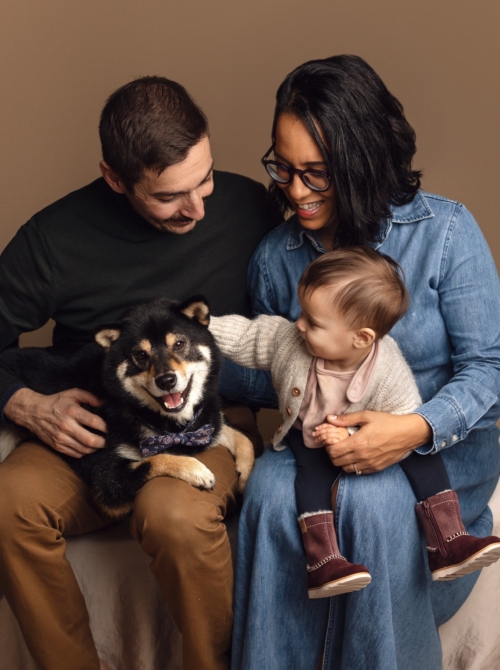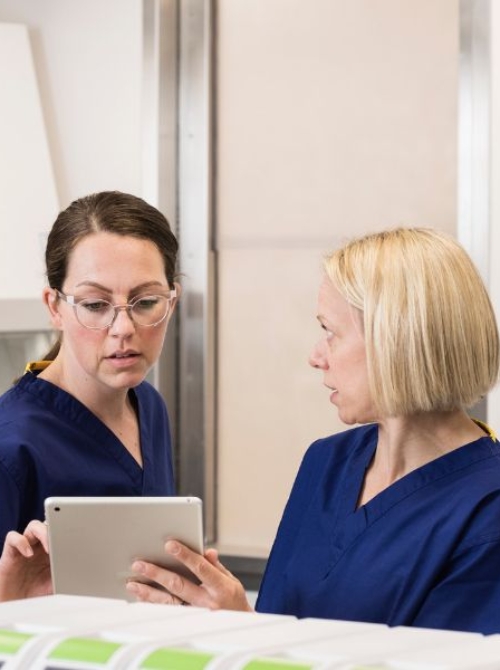“Think about your whole family, not just your first baby.”
Amy’s story of how multiple rounds of IVF in her early 40s and PGT-A completed her family.
“If I could go back in time and have a conversation with my 37-year-old self, standing on the precipice of our first round of IVF, I’d tell her one thing: think about your whole family, not just your first baby.”
Amy’s story of how multiple rounds of IVF in her early 40s and PGT-A completed her family.
“If I could go back in time and have a conversation with my 37-year-old self, standing on the precipice of our first round of IVF, I’d tell her one thing: think about your whole family, not just your first baby.
I didn’t do that. I was so desperate to become a mother, so consumed by the struggle of TTC (trying to conceive), that I never stopped to consider what it would mean for our future. That’s a lesson I learned the hard way through heartbreak, exhaustion, and more IVF cycles than I ever imagined I’d endure.
The early days of TTC
We started trying for a baby a year after getting married. I was 36, and I knew I didn’t have the luxury of time. Month after month, the single pink line on the pregnancy test became my heartbreak ritual. By the time I turned 37, I’d had enough of waiting, hoping, and failing. We turned to IVF.
I thought IVF would be the answer. I thought science would fix what nature hadn’t given us. But two rounds, multiple embryo transfers, two years, and no pregnancies later, my hope was wearing thin. Then, in my third cycle, just before my 39th birthday, we finally had embryos for transfer.
I remember lying in the transfer room, staring at the ceiling, as they transferred one of those tiny, microscopic bundles of cells inside me. It felt like everything was riding on that moment. And then, for the first time, two weeks later, I saw two pink lines. And nine months later, my daughter was born – just a few weeks before I turned 40. She was everything. She is everything. And for a while, I thought that was enough.
Until it wasn’t.
Negotiating a FET with a toddler at home
A year after she was born, we tried again. Another frozen embryo transfer. Another heartbreak. This time, there were no two pink lines. Just another failed cycle, another wound to heal. We told ourselves it was OK, that we were lucky to have her, that we would be a family of three. But six months later, the ache returned. I couldn’t shake it. I wanted another baby. I wanted my daughter to have a sibling.
I was 42 when I walked through the doors of The Evewell for the first time, I knew the odds were stacked against me. My consultant – Mr Davis – was upfront: at my age, success was slim. But if we could get a euploid embryo (a ‘normal’ embryo, through PGT-A testing), my chances would be much better.
PGT-A? It was the first time I’d ever heard those four letters put together. No one had even mentioned it to me before. If they had, I would have done things differently. If I had known this was an option and a way to secure embryos to gift back to a future me, I would have had more egg collections and tried to get more embryos when I was younger. I would have tested them, frozen as many normals as I knew I needed to complete my family, and saved myself the heartbreak I was about to endure.
Because what followed was brutal.
The reality of IVF in my early 40s
IVF in my early 40s was nothing like it had been in my late 30s. It was harder. On my body. On my mind. On my marriage. And this time, I wasn’t just an IVF patient – I was a mother.
I’ll never forget doing injections in the kitchen while scrambling eggs for my toddler. Sneaking off to the bathroom during playdates to mix the medication. Trying to sleep next to her cot, utterly exhausted, knowing I’d be up at 6am to drive into London for another scan, another blood test. All while my husband was at home, unable to come with me due to Covid restrictions.
I went through two full cycles, retrieving eggs, creating embryos, sending them off for PGT-A testing, hoping, praying, and waiting for the call that would tell me we had a chance.
Each time, the news was the same: none of them were normal. None of them would give us a baby.
I sobbed in the car after that second call. I had given so much, and gone through so much, and it still wasn’t enough.
That’s the cruel reality of IVF when you’re older. It was a numbers game, and I was losing.
Our final shot
We decided to try one last time. One final cycle. And somehow, against the odds, we struck gold. Three embryos. One came back normal.
I can still hear the Christian, the embryologist’s voice on the phone: “We have one.”
I cried. My husband cried. It was a relief, but it was also pressure. This was our one shot.
My consultant, Mr. Davis, made it clear: he would do everything in his power to make sure my body was ready for this embryo. And so began another round of tests: ERA, Emma and Alice, Natural Killer Cells… We threw the kitchen sink at it.
By the time transfer day arrived, I was exhausted in every possible way. I walked into that clinic alone, my husband and daughter waiting outside a café practising social distancing. I lay on the table as the embryologist and consultant worked, trying to ignore the fear that gripped me.
Would this be the last time I’d ever do this? Would it work? Would I walk away from this still a mother of one, or would I finally get to hold the second baby I had dreamed of for so long?
The two-week wait from hell
The two-week wait was hell. I was so afraid of another failure that I didn’t even test in the morning. I waited until my daughter was in bed. My husband and I sat together, staring at that pregnancy test, waiting for our future to be decided.
Two lines.
And then came the fear.
Because that’s what IVF does to you. It robs you of joy. It replaces it with terror. What if it’s a chemical pregnancy? What if there’s no heartbeat at six weeks? What if I miscarry? What if the 20-week scan finds something wrong? What if…
That fear didn’t leave me until she was in my arms. Three weeks early, screaming her tiny lungs out at 2 am.
And then, finally, I breathed.
If I could go back and tell my younger self anything about IVF…
If I had known about PGT-A before I transferred the embryo that became my first daughter, my journey would have been different. I wouldn’t have had to go through three egg collections in my 40s just to get my second daughter. I wouldn’t have lost so much time, energy, money, and pieces of myself along the way.
We were one of the lucky ones. Only 51% of women my age get pregnant even with a normal embryo. And I owe so much to The Evewell for giving us the best possible chance. But the biggest lesson I learned?
Think about the family you want – not just the first baby, but all of them – before you start transferring embryos. Because if I could go back and do it all again, that’s exactly what I would do.”


